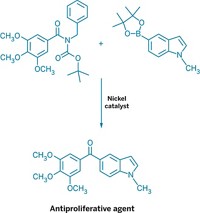Advertisement
Grab your lab coat. Let's get started
Welcome!
Welcome!
Create an account below to get 6 C&EN articles per month, receive newsletters and more - all free.
It seems this is your first time logging in online. Please enter the following information to continue.
As an ACS member you automatically get access to this site. All we need is few more details to create your reading experience.
Not you? Sign in with a different account.
Not you? Sign in with a different account.
ERROR 1
ERROR 1
ERROR 2
ERROR 2
ERROR 2
ERROR 2
ERROR 2
Password and Confirm password must match.
If you have an ACS member number, please enter it here so we can link this account to your membership. (optional)
ERROR 2
ACS values your privacy. By submitting your information, you are gaining access to C&EN and subscribing to our weekly newsletter. We use the information you provide to make your reading experience better, and we will never sell your data to third party members.
Synthesis
Amine Synthesis Gains Utility
Reaction combines C-H functionalization of an amine with its addition to an olefin to form a new amine
by Stephen K. Ritter
May 21, 2007
| A version of this story appeared in
Volume 85, Issue 21

The catalytic reaction of an N-alkyl arylamine with an unactivated olefin to produce a β-branched alkyl arylamine has been carried out for the first time in high yield (J. Am. Chem. Soc. 2007,129, 6690). This reaction, which involves activation of a C-H bond adjacent to the amine nitrogen atom, is anticipated to complement existing strategies for synthesizing amines from olefins.
The chemists reporting this advance, Seth B. Herzon and John F. Hartwig of the University of Illinois, Urbana-Champaign, have dubbed the reaction hydroaminoalkylation. This reaction has been reported in the literature before, but until now it hadn't been refined to make it useful to synthetic chemists, according to Herzon and Hartwig.
In one example, the Illinois team reacted N-methylaniline with 1-octene at 160 oC using a tantalum catalyst, Ta[N(CH3)2]5, to form N-(β-methyloctyl)aniline in greater than 95% yield.
The β-branched product is the sole detectable regioisomer in the reactions, Hartwig notes. That type of reaction selectivity is unusual, he says, because it means that a C-H bond of the methyl group of N-methylaniline is activated, rather than the typically more reactive N-H bond or unsaturated C-H aryl bonds.
Additional progress needs to be made before the reaction "is truly practical," Hartwig tells C&EN. For example, it will be important to reduce reaction temperatures and to develop catalysts and conditions for reactions involving internal olefins, including cyclic olefins, he says. Hartwig suggests that direct alkylation of saturated nitrogen heterocycles is the most obvious application for the new reaction.
The work "is a significant step forward in the functionalization of C-H bonds adjacent to a nitrogen atom," says Brandeis University's Jin-Quan Yu, who has devised several C-H activation processes. Besides building on C-H activation using early transition metals (groups 3-5), this chemistry complements the amination process developed by Hartwig and Stephen L. Buchwald of Massachusetts Institute of Technology, which is used broadly in the pharmaceutical industry for arylamine syntheses, Yu notes.
"I'm amazed at the novel and useful chemistry that continues to emerge from early-transition-metal amide complexes," adds Patrick J. Walsh of the University of Pennsylvania, who conducts research using those metal catalysts. The new reaction "is an impressive demonstration" of C-H activation followed by C-C bond formation with good selectivity, he says. "It's sure to inspire others to explore this area."





Join the conversation
Contact the reporter
Submit a Letter to the Editor for publication
Engage with us on Twitter